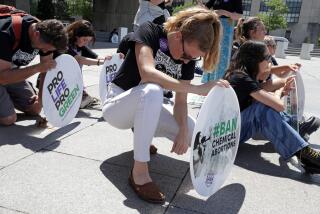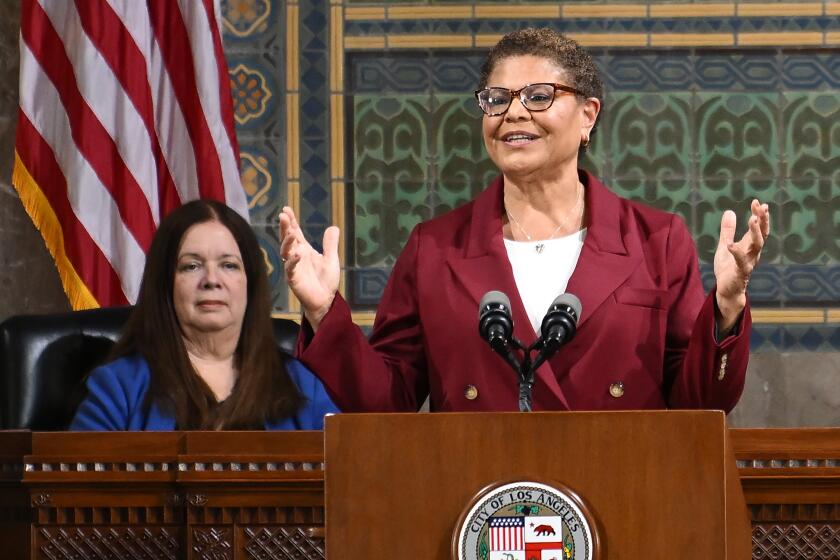Antiabortion cause stirs new generation

- Share via
WALLINGFORD, PA. — The bell rang and the eighth graders jumped up, eager to compare notes.
“I named my baby Kyle Patrick,” one shouted.
“Mine is Antonio!”
At the urging of an antiabortion activist, they had each pledged to “spiritually adopt” a fetus developing in an unknown woman -- to name it, love it from afar and above all, pray daily that the mother-to-be would not choose abortion.
“Maybe one day you’ll get to heaven and these people will come running to you . . . and say, ‘We’re all the little children you saved,’ ” activist Cristina Barba said. She smiled at the students in their Catholic school uniforms. “Maybe you really can make a difference.”
Thirty-five years after Roe vs. Wade, the U.S. Supreme Court decision legalizing abortion, opponents are pouring resources into building new generations of activists. Young people are responding with passion.
Today’s students and young adults have grown up in a time when abortion was widely accessible and acceptable, and a striking number are determined to end that era.
Pew Research Center polls dating back a decade show that 18- to 29-year-olds are consistently more likely than the general adult population to favor strict limits on abortion. A Pew survey over the summer found 22% of young adults support a total ban on abortion, compared with 15% of their parents’ generation.
Looking specifically at teens, a Gallup survey in 2003 found that 72% called abortion morally wrong, and 32% believed it should be illegal in all circumstances. Among adults surveyed that year, only 17% backed a total ban.
These statistics should not obscure the fact -- made clear in poll after poll over decades -- that a substantial majority of Americans want abortion to remain legal in at least some circumstances. And millions of young people continue to choose abortion when faced with unplanned pregnancy; every year, 600,000 women under age 25 abort.
But among those fighting to criminalize the procedure, the young -- trained in antiabortion summer camps and political internships -- are increasingly out front.
“You look at pictures of marches [over the years] and the crowds just keep getting younger and younger and younger,” said Derrick Jones, an advisor to National Teens for Life.
In Colorado, a teenager last year decided the state constitution should define a fertilized egg as a person. Kristi Burton, now 20, won a court fight about her proposed amendment and leads the campaign to put it on the ballot this fall.
In California, a 17-year-old girl last week filed a lawsuit in federal court for the right to start a “pro-life club” at her San Jose-area high school. A Virginia teen recently took similar legal action, and her school promptly dropped its objection to the club.
Here in greater Philadelphia, the antiabortion group Generation Life enlists teens to hand out literature on beaches and guides them through role-playing to hone their powers of persuasion.
At a recent workshop, Claire Levis, 17, played the part of an abortion-rights supporter. “My friend got raped and you want her to have the baby? How can you ask a 15-year-old to go through a pregnancy? That’s nine months of ridicule and pain,” she shouted.
Liz Coyle, 16, responded: “It’s not the baby’s fault. He’s never done anything wrong.”
Liz then added: “There are plenty of teachers willing to home-school your friend if she doesn’t want to go to class when she’s pregnant. Or she could go to school, and stand up for herself.”
The dozen teens watching burst into applause.
“I feel like we’re all survivors of abortion,” Claire said.
She has five sisters and a brother; most of her classmates, she said, come from much smaller families. The way Claire sees it, they’re missing out on much joy -- and she blames abortion.
“I look at my friends,” she said, “and I wonder, ‘Where are your siblings?’ ”
This sense that millions of their peers are missing motivates many young activists.
They are also the first generations to grow up seeing images from inside the womb displayed like prized family photos -- tacked to the fridge, posted on the Web, pasted into scrapbooks. Ultrasound videos even interrupt their TV shows; the conservative advocacy group Focus on the Family bought ad time to air fetal pictures during “American Idol Rewind” and a college football all-star game.
“Abortion feels more personal for us,” said Kristan Hawkins, who supervises 400 college clubs through the group Students for Life of America.
Abortion-rights supporters are also reaching beyond the old guard of leaders, which veteran activist Nancy Keenan refers to as “the menopausal militia.”
Like their opponents, abortion-rights groups sponsor college clubs and train students as peer educators. They’re also turning to Facebook, MySpace and text-messaging to recruit and energize students. NARAL Pro-Choice America has even produced a series of YouTube clips, meant to look like a college student’s video blog, to encourage grass-roots organizing.
But far more viewers have clicked on YouTube’s many antiabortion offerings, including undercover footage -- filmed by a UCLA sophomore -- of an abortion-clinic clerk suggesting that a teen lie about her age on the admissions form so her much-older boyfriend would not be reported for statutory rape.
Some analysts believe that liberals have lost support among young people by failing to acknowledge that many find abortion deeply troubling, even if they support the core principle of choice.
In a speech last week, Keenan, president of NARAL, acknowledged as much. “Our reluctance to address the moral complexity of this debate is no longer serving our cause -- or our country -- well,” she said.
In the years after Roe, “the pro-choice community alienated a lot of young women,” said Cynthia Gorney, author of “Articles of Faith: A Frontline History of the Abortion Wars.”
“They haven’t found a way to get them back,” Gorney said. “This is one of their huge failings.”
To regain momentum, major abortion-rights groups plan to shift tactics this year. They hope to win over young people by focusing on issues less controversial (and to many students, more pressing) than abortion, such as the rising price of birth control on college campuses.
“You have to go to where they are,” Keenan said.
That’s a strategy that antiabortion activists are already putting to work.
At St. John the Evangelist, a Catholic church in Philadelphia, Father David Engo encourages the passion he sees in young adults for social justice.
Engo organizes volunteer work at an AIDS hospice and among the homeless. Then he explains that he sees the antiabortion cause as part and parcel of such work -- yet another way to fulfill Christ’s commandment to serve the least among us.
That connection inspired Bill Gonch, a 23-year-old administrative assistant.
“I didn’t know any pro-life people before I joined the church. All I knew was what I saw on the news -- a lot of noise, a lot of anger,” Gonch said. “It surprised me how caring and loving they were. . . . And it’s more of a youth movement than I expected.”
The next time the church’s young-adult club gathers for peaceful protest outside an abortion clinic, Gonch plans to be there, praying.
More to Read
Sign up for Essential California
The most important California stories and recommendations in your inbox every morning.
You may occasionally receive promotional content from the Los Angeles Times.












![Vista, California-Apri 2, 2025-Hours after undergoing dental surgery a 9-year-old girl was found unresponsive in her home, officials are investigating what caused her death. On March 18, Silvanna Moreno was placed under anesthesia for a dental surgery at Dreamtime Dentistry, a dental facility that "strive[s] to be the premier office for sedation dentistry in Vitsa, CA. (Google Maps)](https://ca-times.brightspotcdn.com/dims4/default/07a58b2/2147483647/strip/true/crop/2016x1344+29+0/resize/840x560!/quality/75/?url=https%3A%2F%2Fcalifornia-times-brightspot.s3.amazonaws.com%2F78%2Ffd%2F9bbf9b62489fa209f9c67df2e472%2Fla-me-dreamtime-dentist-01.jpg)
